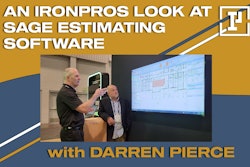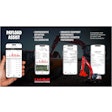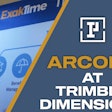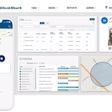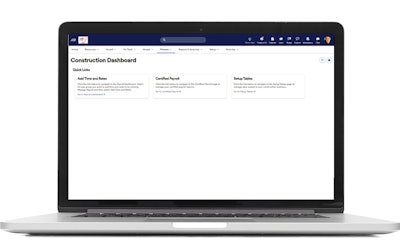
At a time when the construction workforce will need to grow to keep up with demand, contractors who aren’t already using construction software for attracting, retaining and capturing value from workers may be looking into it now.
It is in this environment that ADP launches Workforce NowⓇ for Construction, billed as the first comprehensive human capital management (HCM) solution built for the unique challenges of the construction industry. The solution is already being run by about 60 construction companies, according to ADP.
Included in Workforce Now for Construction, contractors will find:
- Construction-specific payroll and compliance
- Regulatory requirements tracking and management for single or cross-state operations
- Automated wage and fringe rates for government-funded projects
- Tools to assign and manage union wage rates
- Creation of certified union and payroll reports
- Integration with general ledger to transfer job costs to ERP
- Time and attendance tracking including functionality for employees working on multiple jobs and in different roles
- Automated time tracking
- Time tracking with geofencing
- Compensation benchmarks by industry, geography and position to support hiring and retention
- Recruiting tools for attracting the right workers
- Talent management including employee training, performance and goal management and succession planning
HCM Software for Construction
In the IRONPROS HR & Payroll Tools category, dozens of construction-specific timekeeping, HCM, human resources and labor management products listed rely on ADP for payroll in at least part of their customer base. By vertically extending their multi-industry HCM for construction ADP is disrupting the market in ways that will affect contractors or evaluating solutions like:
- Construction-specific HCM solutions like Arcoro and Criterion
- Timeclock applications like Clockshark and Penta’s Struxi, a well as time cards built into field productivity software products
- Construction payroll solutions like Penta’s solution which was initially marketed as Sage Intacct Construction Payroll
Turning General HCM into Construction HCM
While ADP has had the Workforce Now product in the market for over a decade as a broad, multi-industry solution. ADP was able to take that broad solution and extend it with specific construction human resources software functionality in large part due to its 2021 acquisition of its longtime partner Integrated Design, Inc. (IDI) IRONPROS debriefed ADP Industry Executive Kit Dickinson, who came into ADP with the acquisition as IDI’s president.
“The 2021 acquisition created the opportunity to unify the two product architectures so ADP could deliver industry-specific solutions for a variety of industries, including construction,” Dickinson said. “It made all the sense in the world and that's when we started the journey of not only embedding and integrating our product capabilities, but also our people in building out the industry-specific experience, building out that holistic strategy product, people process partnerships.”
While the goal is verticalization, with construction HCM being among the first areas of focus, but in some cases, functionality developed for one vertical may be useful in other settings, including construction.
“In nonprofit, in particular, a big focus right now is, and it has been for the last few years, around managing your grants, managing your funds in a way that you get true visibility into where dollars from funding sources are being spent,” Dickinson said. “The Bill and Melinda Gates Foundation really kind of brought that private or business mindset into nonprofits, and now we want to see outcomes. We want to see results … And so we have the ability to take that time card information and really provide deep allocation of where the dollars truly were spent.”
What is good for stakeholders in a nonprofit is also good for a construction management team, according to Dickinson, particularly in allocating time of exempt employees across specific projects.
“How that correlates to the construction industry is when you have project managers, let's say that are salaried and generally are treated as overhead,” Dickinson said. “But when they spend time on a project, you want to be able to cost their labor their burden to that job. Through our Workforce Now for Construction. While the focus is on the more traditional hourly or union employee, we do have the ability to help with those more exempt or salaried employees.
Software for managing engineering and architect time are commonly used in those professional services settings, but the dynamic nature of a construction project means allocating labor of project managers and other white collar construction employees can be difficult, at least until after a long and complex reconciliation process.
“It's often too late by the time it hits the books,” Dickinson said.
Not Just Bolted On
Enterprise software acquisitions often yield disjointed product lines that may have a point-to-point integration between products or a middleware layer to unite them.
“A lot of times when you hear them an acquisition, you just wind up with a single sign on” uniting the two products, Dickinson said. “But it's obvious to the user you have two systems. What the product teams here have done so well, together, is take that functionality and really weave it into the user experience. So all they know is that they're interacting with Workforce Now. What's net new as part of that single all-in-one experience is the ability to read time card data, whether it's from our timecard or one of the niche providers in construction and we wanted to be flexible on that front to work with and WorkMax and others. We take that timecard data and handle the complexities of assigning wages and benefits for government contracts, so your prevailing wage, your fringes that are mandated.”
ADP Workforce Now offers similar administrative automation for union shops.
“If you work with unions, you've got their contracts that you have to manage,” Dickinson said. “So it adds a layer of wage determination to get people paid right in the construction space. We've taken that capability and now and its core, it's native in ADP Workforce Now to be able to handle all of those pay rules. After you run payroll, what's also new is the ability to generate those critical certified payroll reports within the product.”
ADP Workforce Now includes templated construction-related personnel reports, including specific ones for states with unique requirements.
Size Matters
ADP’s entry into the construction HCM software market is a big deal in part because ADP is a big company with tremendous reach. Dickinson estimated the number of ADP direct sales reps in a position to sell the new construction HCM product at about 2,000. On top of that, ADP Workforce Now for Construction has an indirect channel including, for instance, Sage’s value-added reseller (VAR) partners. Sage has a significant footprint for construction with its Sage 100 Contractor, Sage 300 Construction and Real Estate and Sage Intacct for Construction enterprise resource planning (ERP) products, plus Sage Estimating and a new Sage Construction Project Management application. This means that Sage channel will be engaged heavily in the construction space.
“ADP’s payroll is Sage’s branded payroll of choice for their Intacct platform,” Dickinson said.
Sage VARs are many, and some are sizable, including RSM US, Armarino, Wipfli, Vision 33 and others.
Once this internal and external team lands a new ADP Workforce Now for Construction customer, they also have access to a deep bench in customer success.
“That’s one of the things that I was most excited about coming from the organization that I ran that brought in,” Dickinson said. “We, we not only brought our technology, but we brought our people and what we've done is built out a Construction Center of Excellence, a trained dedicated team that focuses on implementing our construction clients. We did a ton of research leading up to the launch of Workforce Now for Construction and what we heard loud and clear from the market through focus groups and other activities is we needed to have a product that meets the needs. That's Central. But a close second was we would need to have people that understand the construction industry and an implementation process built for construction. And then also, once they go live, they have a service team also part of that Center of Excellence for the life of the relationship with a dedicated account manager who they go to for their single point of contact.”
ADP Workforce Now for Construction Pricing/Market
Dickinson said the sweet spot for ADP Workforce Now for Construction was the middle market—contractors with more than 50 employees and a floor of about $1 million to $5 million in revenue, but not yet to the enterprise size. The ADP team will put contractors in one of two different buckets and treat them according to their needs.
“The secondary qualifier is, do they work primarily or exclusively in residential, more privately funded projects like commercial or do they work on government projects or projects with unions,” Dickinson said. "And then that again continues to, to refine what part of that Construction Center of Excellence they get assigned to.”
The software is priced on a per-user basis, and Dickinson said a transaction would run between tens of thousands of dollars for a smaller contractor to hundreds of thousands for a larger construction enterprise.
BOTTOM LINE: ADP's verticalization of its HCM product for construction is a big deal in large part because they are a big company with tremendous reach. In HCM, in ERP, in project management, there are both construction-specific and multi-industry software products out there. In the case of ADP and also in the case of Sage, we see multi-industry products being extended further and further into construction. This puts tremendous research and development and sales resources behind a construction software product. Contractors have more choices now than ever before, and as they consider ADP Workforce Now for Construction, they will want to pursue more detailed demos of products to define for themselves which functionality each lacks relative to the other, and how important that functionality is to their success. Some areas to probe are applicant tracking system (ATS) and learning management system (LMS) functionality and how deeply the solution is tied to individual projects. The appeal and flexibility of working with a middle-market software vendor may also be a factor in some construction HCM consideration cycles, as well as the maturity of established vertical solutions. But ADP has come to market with a product that should be considered, particularly for ADP payroll customers.

